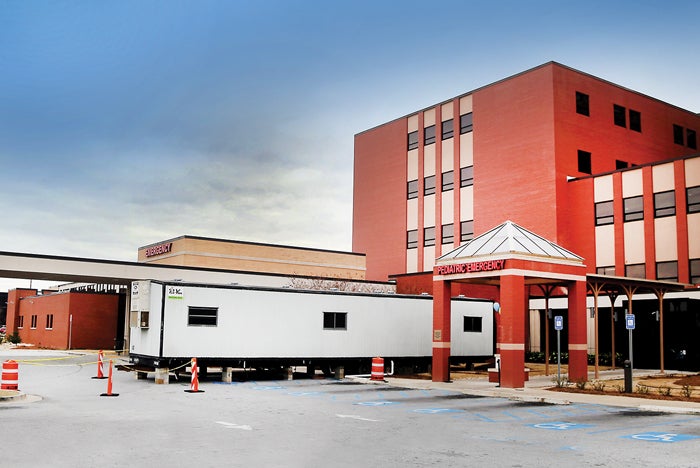ASPR document helps hospitals to handle seasonal flu surge

Piedmont Columbus Regional’s Midtown Campus rented a trailer that can accommodate 21 patients with influenzalike illness to help alleviate overcrowding in its emergency department.
Photo courtesy of Piedmont Columbus Regional
Although the 2017-2018 flu season is waning, it has been recorded as one of the most challenging in recent history. It peaked in early February with 7.5 percent of the U.S. population affected, according to the Centers for Disease Control and Prevention. At press time, that number decreased to 3.7 percent, but was still far above the national baseline of 2.2 percent.
The seasonal-illness surge has caused many health care providers to seek information on how to respond to the sharp increase in patient demand, which in turn prompted the Department of Health & Human Services’ Office of the Assistant Secretary for Preparedness and Response (ASPR) to release a document to assist the health care community.
“Considerations for the Use of Temporary Surge Sites for Managing Seasonal Patient Surge,” prepared by ASPR’s Technical Resources, Assistant Center and Information Exchange (TRACIE), is an 18-page document broken into two major components: Prevention/Mitigation, and Use of Temporary Sites on Facility Property.
Shayne Brannman, director of ASPR TRACIE, says the document was developed with the help of subject matter experts, already available and trusted technical documents, and resources from other health care facilities, accreditation organizations and governing bodies.
“We needed to create this document because these types of events require a different response than one-time surge events,” Brannman says. “It could be two to three months that a hospital will need to respond to this.”
Kaweah Delta Medical Center in California, for instance, erected a second patient surge tent near its emergency department (ED) months after installing its first one in November at the start of the flu season. The tent serves as a staging area for patients who come to the hospital by ambulance, but do not have life-threatening conditions. It allows care providers to take over care for a patient and thereby prevent emergency medical technicians from having to crowd the ED’s hallways with patients who are waiting to be seen. Gary Herbst, CEO of Kaweah Delta Health Care District, says that this is the first time the hospital has set up two tents at one time. On average, the medical center has seen 500 positive flu cases each week.
“Our ED is one of the busiest in the state, seeing 90,000 patients each year, but the demand for our medical services has increased to the point that we have to take further steps to best care for each person seeking medical care,” Herbst says.
In Georgia, Piedmont Columbus Regional’s 583-bed Midtown Campus rented a trailer that can accommodate 21 patients. The hospital’s ED reported an average of 50 to 100 influenzalike illness (ILI) cases per day. The hospital’s facilities team made cosmetic improvements, such as cleaning and painting the interior, and placing a skirt around the exterior to make it more aesthetically pleasing to patients and staff. The trailer is dedicated to patients with ILI and has two exam spaces, and a triage and registration area.
Hospital representative Jessica Word Roberts says the trailer has helped to reduce wait times, and eliminated the need for patients with ILI to enter the main hospital and risk spreading it to other patients.
Brannman says there are many ways hospitals choose to handle seasonal patient surges. While the TRACIE document can help to guide individual facilities to the most appropriate solution for each case, she says that all health care organizations should establish an incident command structure.
“No one can respond to any one event in a silo,” she explains. “You need representatives from the core units of the hospital to ensure smooth coordination and to ensure that the hospital leadership has the information to make the best decisions.”




